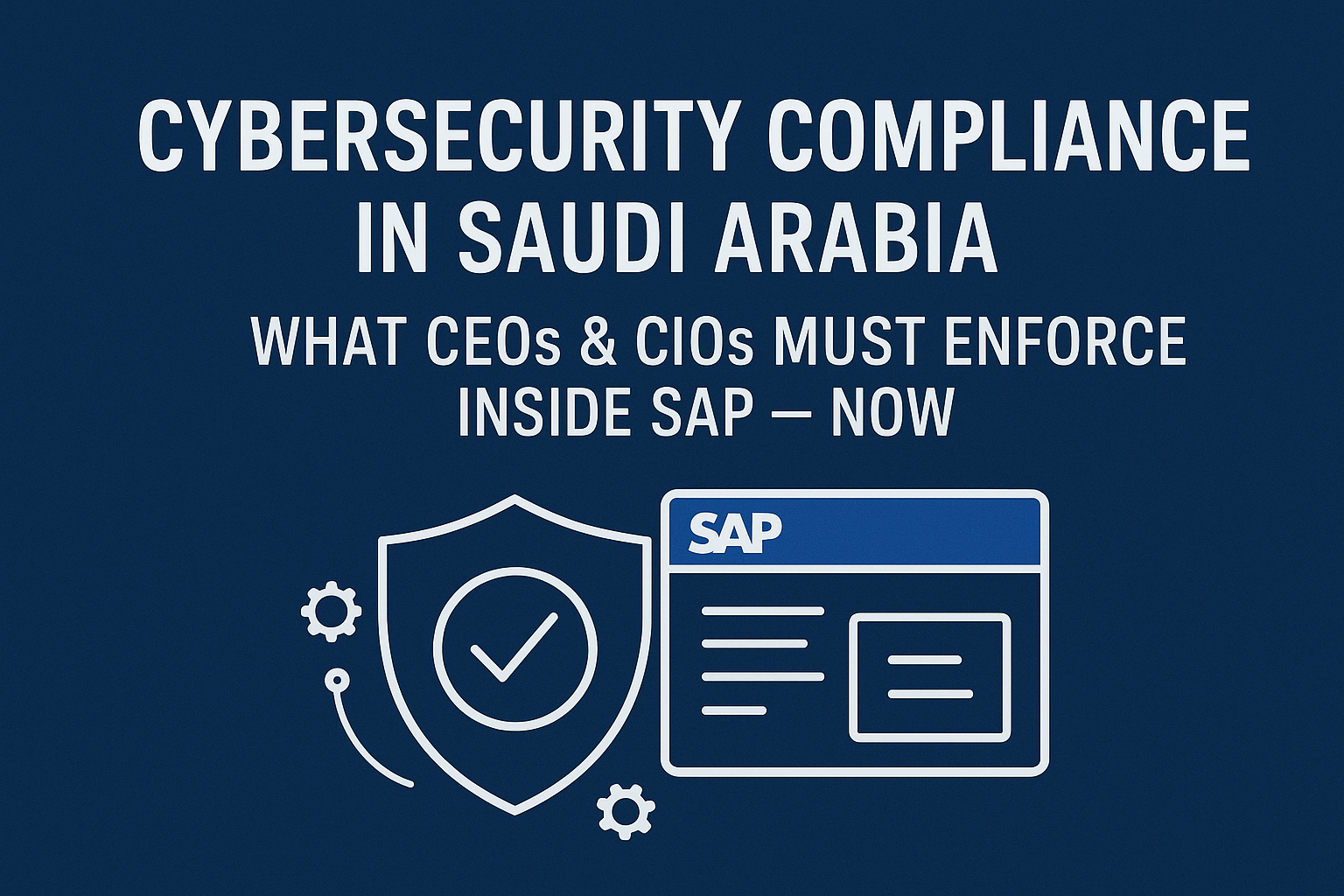Enterprises of all sizes depend on SAP systems to run critical operations. Modern SAP environments drive efficiency, support financial reporting and enable fast adaptation to market demands. Yet as the complexity of digital systems grows, SAP authorization management becomes a challenging endeavor for organizations worldwide. Manual processes often hold inherent limitations which can introduce unnecessary risks. This blog explores how automation is shaping the future of SAP authorization management, highlighting benefits, pitfalls of traditional methods and practical steps to implement robust automated solutions.
The Importance of SAP Authorization Management
SAP systems contain sensitive business data, financial information and confidential records. The authorization framework controls user access to these assets, making it essential to get right. Businesses must safeguard their systems from unauthorized use, both from internal users and external threats. Failing to properly manage SAP authorizations can lead to data breaches, regulatory penalties or compliance failures.
Authorization management also impacts daily productivity. If employees struggle to access necessary data, delays arise. On the other hand, over-provisioning access increases the risk of segregation of duties violations. For these reasons, companies seek solutions that balance strong security with operational efficiency. Automation offers a promising avenue to achieve this balance at scale.
Common Challenges in Manual SAP Authorization
Traditional authorization management heavily relies on manual processes. Administrators grant roles, review user requests and document changes using spreadsheets or email. While such methods might work for small deployments, they do not scale. Errors can easily go unnoticed in environments with thousands of users and roles. Manual reviews can miss subtle risks, especially when time pressures mount during audits or compliance checks.
Manual methods also slow down onboarding and offboarding. New employees may wait days for access, while overlooked permissions for departing staff pose potential risks. These inefficiencies have direct consequences for cost, productivity and compliance. Mounting regulations such as GDPR, SOX or ISO 27001 amplify the costs of mistakes. Regulatory bodies expect timely and auditable management of access rights, demands that manual systems often struggle to meet.
How Automation Transforms SAP Authorization Processes
Automation streamlines SAP authorization management by introducing consistency, accuracy and speed. Automated workflows replace repetitive manual steps with intelligent algorithms and pre-defined rules. For instance, user provisioning becomes faster as automation matches user profiles with relevant roles based on their position or department.
Routine access reviews no longer require hours of manual sifting through spreadsheets. Instead, scheduled reporting and analysis highlight risky permissions instantly. Automation alerts administrators to unusual patterns or policy violations so problems can be addressed proactively. With compliance regulations growing ever more stringent, automation supports robust recordkeeping and transparent audit trails.
These tools also reduce the burden on IT teams by simplifying delegation. Business managers can approve standard access requests through automated self-service portals, freeing technical staff to focus on strategic projects. Time-consuming tasks such as password resets or de-provisioning can occur automatically when specific triggers occur, ensuring former users no longer retain unauthorized access.
Risk Reduction Through Automated Controls
Minimizing risk in SAP environments requires a systematic approach to managing permissions and monitoring usage. Automated controls play a vital role in this process. By consistently enforcing policies, organizations can prevent common issues such as excessive access or conflicting roles. Automated segregation of duties checks immediately flag any overlap that might allow fraud or policy violations. This approach helps organizations maintain regulatory compliance without slowing daily operations.
Additionally, automation can enforce real-time monitoring of user activities. If a user accesses or modifies sensitive data outside of normal parameters, automated alerts can prompt instant review. Advanced automation tools integrate with existing security frameworks, providing a comprehensive view of system health. By combining role design, provisioning and monitoring, organizations can take a proactive stance on risk management.
Simplifying S/4HANA Migrations With Automation
Upgrading to SAP S/4HANA represents a significant transformation for many companies. The shift brings opportunities for improved performance and new business processes, but also challenges related to authorizations. Migrating legacy roles to the new platform involves mapping, testing and optimizing access rights for new workflows. Manual methods often fail to capture all necessary changes, increasing the risk of misaligned permissions and compliance gaps.
Automation streamlines every phase of an S/4HANA migration. Assessments of current roles identify redundant or obsolete permissions. Automated mapping tools translate legacy authorizations into the new S/4HANA environment, enforcing policy consistency. Testing becomes faster, as automated scripts simulate real-world scenarios and highlight potential conflicts before users go live. Post-migration, automation ensures ongoing compliance with integrated access reviews and regular monitoring.
Managing Complex Role Designs
Modern business processes frequently involve cross-functional workflows that require highly tailored roles. Manual design and testing can make this effort error-prone and time-consuming. Automation helps by validating role designs against organizational policies and regulatory requirements, ensuring newly created roles meet all necessary criteria from the outset. This level of assurance supports seamless business transitions and ongoing audit readiness.
Enhancing Segregation of Duties With Automation
Segregation of Duties (SoD) forms a core component of internal controls in any financial or operational system. The goal is to separate critical responsibilities so that no individual has enough control to commit fraud or make unauthorized changes. In SAP environments, achieving strict SoD polices proves difficult without technological support, especially as processes become more interconnected and dispersed.
Automated SoD management tools continuously monitor user access and flag any violations in real time. Administrators can establish standard policies for all business functions, then rely on automation to enforce those rules consistently. Automated reporting provides clear records of SoD reviews, simplifying preparations for audits. This seamless integration of controls helps organizations reduce security loopholes while supporting a smoother compliance journey.
Meeting Regulatory Standards Through Automated Management
Regulatory demands like GDPR, SOX and ISO 27001 emphasize secure data handling and transparency in access management. Auditors expect organizations to back up their claims with detailed, timely records. Relying on manual logs makes producing this documentation a stressful, labor-intensive process. Automated SAP authorization management supports compliance through integrated tracking, reporting and alerting features.
Automated workflows embed compliance checks directly into authorization assignments. Every change leaves an audit trail, so organizations can demonstrate exactly who accessed which data and when. Automated recertification ensures that historical access remains appropriate as roles or organizational structures change, minimizing the risk of compliance lapse between scheduled audits. In this way, automation acts as a foundation for both operational excellence and regulatory peace of mind.
Detecting Policy Deviations Promptly
Traditional manual reviews may only happen once or twice a year, leaving room for months of unaddressed risk. Automation brings near real-time analysis to detected deviations from policy or emerging threats. Reports can be generated on demand to satisfy auditor requests and demonstrate proactive compliance posture. As risk environments shift, automated controls adapt more quickly than manual processes ever could, further supporting organizational resilience.
Empowering Users With Self-Service Capabilities
Modern organizations benefit when business users gain more direct control over their access needs. Manual request-and-approval cycles slow business processes. Automation addresses this pain point through self-service access portals, where end users can request roles or permissions within predefined boundaries. Approved requests update systems automatically, reducing both administrative bottlenecks and error rates.
This approach not only streamlines routine changes but also empowers line managers to take more responsibility in access governance. Instead of burdening IT with every modification, business leaders approve standard requests for their teams. Automated workflows ensure that all changes stay within established policy limits, with exception cases flagged for review. By distributing access management, organizations foster a culture of shared accountability and risk awareness.
Integrating AI and Analytics for Improved Security
Artificial Intelligence (AI) and advanced analytics further enhance automation in SAP authorization management. AI-powered systems identify trends or anomalies that might escape traditional filters. For example, machine learning algorithms can detect subtle patterns in access requests or usage, predicting potentially risky behaviors before they escalate.
Analytics engines review large datasets to highlight unusual permission assignments or usage spikes. Automated tools can prioritize review queues based on risk, ensuring swift attention to the most pressing issues. As threats continue to evolve, AI adapts to new attack vectors and changing business needs, continually optimizing the balance between access and security.
Gaining Actionable Insights
Organizations gain strategic advantage from automated insights. Regular dashboards provide leaders with clear visibility into access trends, compliance status and upcoming audit needs. By moving beyond static reports, businesses identify gaps, implement improvements and measure results over time. Data-driven decision making encourages continuous enhancement of security postures, benefiting all stakeholders.
Practical Steps for Implementing Automation
Introducing automation into SAP authorization management requires careful planning and stakeholder engagement. Organizations should start with a comprehensive assessment of current processes, identifying bottlenecks or redundant steps. Clear documentation of business roles, responsibilities and risk criteria helps lay a solid foundation.
Next, organizations can select automation tools that match their unique needs. Pilot programs test workflows in a controlled environment, allowing teams to fine-tune processes before scaling up. Ongoing training and support for users ensure successful adoption, while continuous monitoring helps to identify new opportunities for improvement.
Balancing Flexibility and Security
Automated systems must meet security standards but also support the flexibility organizations require. Designing clear escalation paths for exceptions prevents overly rigid controls from hindering legitimate business needs. Regular stakeholder engagement ensures that automation remains in sync with business realities, keeping risk low while supporting productivity.
The Role of Culture and Change Management
Technology alone cannot solve every problem in SAP authorization management. Cultural attitudes toward security, compliance and risk play a significant part in the equation. Successful automation projects invest in change management, providing training and clear communication for users at all organizational levels.
Leaders can reinforce good practices by recognizing teams who excel at following automated processes. A strong culture of compliance rewards proactive management of access rights and encourages open discussion about potential risks. Involving business stakeholders early in automation projects helps build buy-in and ensures lasting value beyond technical deployment.
Trends Shaping the Future of Automation in SAP Authorizations
The landscape of SAP authorization management continues to advance as automation expands its reach. Integration with cloud-based platforms introduces new opportunities for scalable, agile deployments. Increasing adoption of zero trust security models challenges traditional perimeter-based controls and boosts the value of role-based automation. Regulatory changes prompt updates to automation policies and capabilities, keeping organizations on their toes.
With the growing importance of privacy regulations, organizations must methodically document and enforce data access policies. Automation offers the necessary transparency and consistency needed for international compliance. As SAP environments evolve, automated authorization management stands as a cornerstone of operational stability and risk reduction, enabling organizations to focus resources on strategic growth and innovation.





